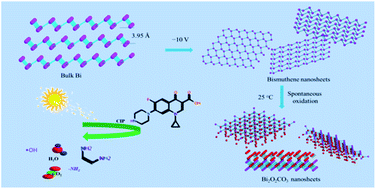Few-layer Bi2O2CO3 nanosheets derived from electrochemically exfoliated bismuthene for the enhanced photocatalytic degradation of ciprofloxacin antibiotic
Abstract
Few-layer two-dimensional (2D) Bi2O2CO3 nanosheets with a thickness of 4–5 nm were successfully fabricated via electrochemical exfoliation, followed by an exposure to ambient conditions. The formation process for these nanosheets was explored through ex situ X-ray diffractometer. The photocatalytic capacity of 2D Bi2O2CO3 nanosheets was investigated towards the degradation of ciprofloxacin. It was shown that 2D Bi2O2CO3 nanosheets exhibited better catalytic performance than Bi2O2CO3 nanoparticles synthesized by hydrothermal method under UV-Vis light irradiation. The enhanced photocatalytic activity is due to the larger specific surface area, as well as the lower band gap. Additionally, the radical trap experiments demonstrate that holes and hydroxyl radicals are of great importance in the degradation of ciprofloxacin. Finally, the 2D Bi2O2CO3 nanosheets show high stability in the photocatalytic degradation of ciprofloxacin, and could have a prospective application in the treatment of antibiotic wastewater.



 Please wait while we load your content...
Please wait while we load your content...